| Author |
Message |
 |
|
|
 |
|
Advert
|
Forum adverts like this one are shown to any user who is not logged in. Join us by filling out a tiny 3 field form and you will get your own, free, dakka user account which gives a good range of benefits to you:
- No adverts like this in the forums anymore.
- Times and dates in your local timezone.
- Full tracking of what you have read so you can skip to your first unread post, easily see what has changed since you last logged in, and easily see what is new at a glance.
- Email notifications for threads you want to watch closely.
- Being a part of the oldest wargaming community on the net.
If you are already a member then feel free to login now. |
|
 |
![[Post New]](/s/i/i.gif) 2016/03/11 22:58:49
Subject: [Blog] Starting a Game Company - Starting from Scratch
|
 |

Decrepit Dakkanaut
|
OK, no problem. BTW, the baseline should probably be the heels, not the toes... 
|
|
|
|
 |
 |
![[Post New]](/s/i/i.gif) 2016/03/11 23:04:34
Subject: [Blog] Starting a Game Company - Starting from Scratch
|
 |

Thermo-Optical Spekter
|
That's not a bad lineup at all.
|
|
|
 |
 |
![[Post New]](/s/i/i.gif) 2016/03/11 23:28:57
Subject: [Blog] Starting a Game Company - Starting from Scratch
|
 |

[DCM]
.
|
REALLY looking forward to this one!
(Did you get my last PM?)
|
|
|
 |
 |
![[Post New]](/s/i/i.gif) 2016/03/11 23:30:17
Subject: [Blog] Starting a Game Company - Starting from Scratch
|
 |

Infiltrating Prowler
|
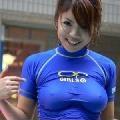 JohnHwangDD wrote: JohnHwangDD wrote:OK, no problem. BTW, the baseline should probably be the heels, not the toes... 
Hehehe, yes definitely. That is why I mentioned it is hard to do a line up when everything has a different physical stance. That is why I would want to swap out artwork for actual 3d renders since a front view would be a complete front straight view, not at an above angle looking down or back, depending on the perspective of the drawing. This was meant as a rough ouline but definitely keep the suggestions coming.
The way the artwork is drawn is to show all the aspects from the forward view. The back view is probably more accurate that the heal is at zero, but doing rear views although funny, doesn't show the lineup with the eyes properly. The only one that is a true straight front view, not in a stance or strange angle to show the designs is the Psion (2nd from the right). Even then the flat part of her foot, the heel is actually visually still slightly above the top of the toes. That is why she sits on the line, going slightly over it though.
The concept art won't be 100% accurate either, there are some design changes that go from it to actual 3d sculpting. The Cyberoid, although I like the various art for the design, the torso and limbs are too thin for my tastes. I can choose make him taller than the average human like he is shown, but bulk him more or shrink him a bit smaller which may result in bulking him some as well. However I wouldn't do that at the risk of making him look stubby, he should have a natural look. That is where the touch up and redesigns will come in effect.
I do have a better picture of the Current Gen Power Armor too but it is in PSD format. I'll create a better silhouette with that, so it isn't standing off at a side angle which will line up better visually.
I will also want to make the lineup a bit bigger, probably spaced out a little more between the designs. Ultimately I'd like to label who is what as we continue to develop them further.
Thank you! Putting the artwork side by side though, definitely lets me see where some things need to bulk up, other parts need to adjust sizes. I should get the 3d human naked model that the initial line was sculpted on and add that. That will help me determine that proportionally arms, legs, torso are the correct sizes so I don't get a stumpy heroic look. Automatically Appended Next Post: Ok here is an updated version. There are still a few things that aren't correct and will need to be adjusted either the concept art or simply during sculpting. Once those are corrected then I can swap the correct version into the lineup to make it work out. Later on I'll probably do an actual redo of the whole lineup with 2d artwork that was actually designed for the purpose of a group picture like this. None of the art was really created with that in mind so stances, poses, etc are off.
Version 1.5
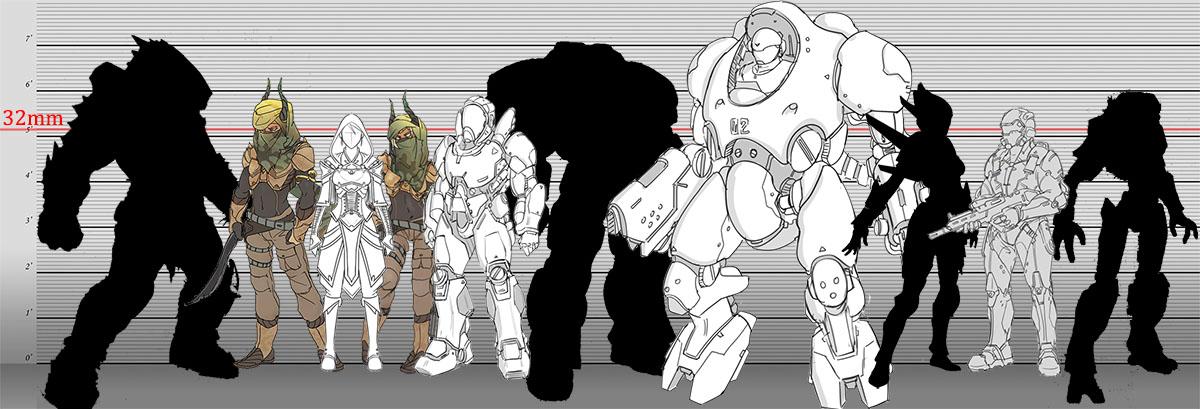
|
|
This message was edited 1 time. Last update was at 2016/03/12 07:23:17
|
|
|
 |
 |
![[Post New]](/s/i/i.gif) 2016/03/13 01:54:05
Subject: Re:[Blog] Starting a Game Company - Starting from Scratch
|
 |

Infiltrating Prowler
|
Ok here is the 2.0 Version of the Size Chart. This is still very much a work in progress, it is still difficult when dealing with different artwork that have different facings, head tilt and stances to approximate them. I tried to line up at least one of the heels with the base of the wall they are lined up against. Once we truly finalize everything I will probably have the artists do an actual Lineup all in similar stances and poses. I could also simply swap out the 2d versions for the 3d versions as well.
The darker silhouettes aren't closely finalized, those all need updates to them which is why they are dark silhouettes. Some of the drawings were done with heroic scale in mind, so they'll have to be adjustments to parts of their bodies as well. This was actually pretty fun to do.
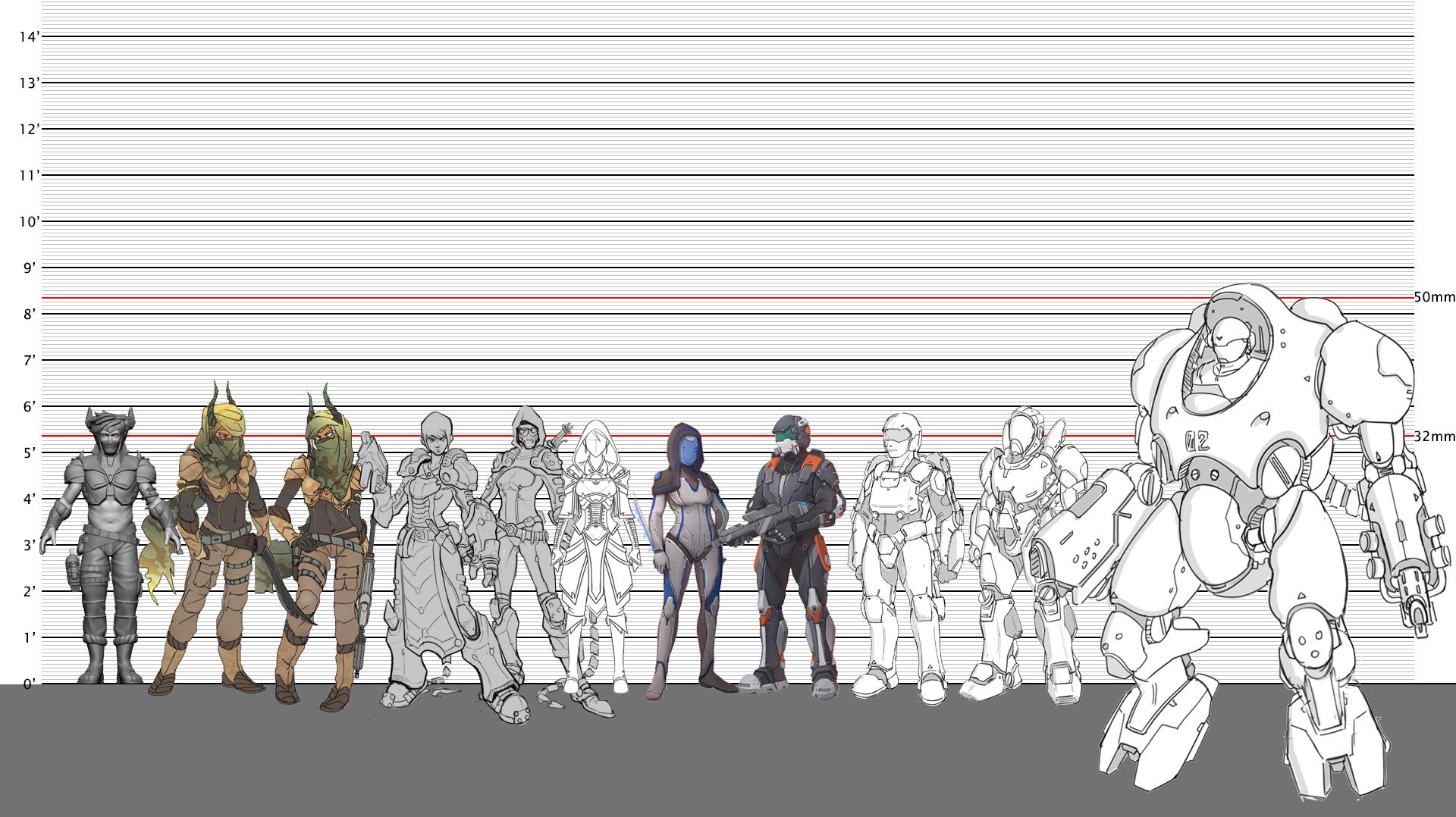 Left to Right: Light Infantry Scout 3d (AD), Light Infantry Scout 2D (AD - male), Light Infantry Scout (AD - female), Medium Infantry (EC), Light Infantry Scout (EC), Psion Version-A (EC), Psion Version-B (EC), Light Infantry (UR), Light Infantry (FC), Heavy Infantry (FC), 1st Gen Power Armor (FC)
Left to Right: Light Infantry Scout 3d (AD), Light Infantry Scout 2D (AD - male), Light Infantry Scout (AD - female), Medium Infantry (EC), Light Infantry Scout (EC), Psion Version-A (EC), Psion Version-B (EC), Light Infantry (UR), Light Infantry (FC), Heavy Infantry (FC), 1st Gen Power Armor (FC)
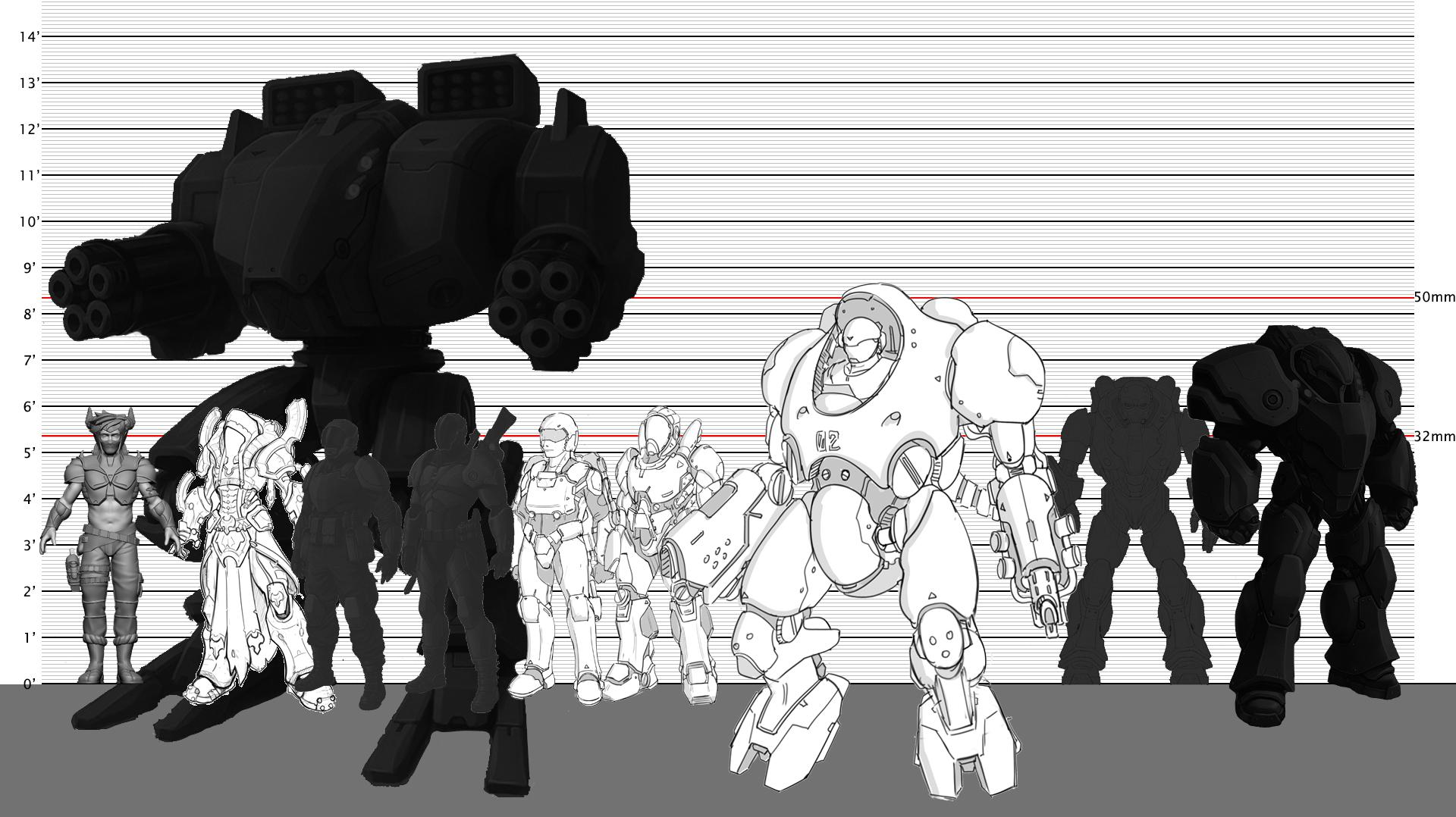 Left to Right: Light Infantry Scout 3d (AD), Mecha (UR), Heavy Infantry (EC), Light Infantry, Medium Infantry, Light Infantry (UR), Light Infantry (FC), Heavy Infantry (FC), 1st Gen Power Armor (FC), 2nd Gen Power Armor (FC), Current Gen Power Armor (UR).
Left to Right: Light Infantry Scout 3d (AD), Mecha (UR), Heavy Infantry (EC), Light Infantry, Medium Infantry, Light Infantry (UR), Light Infantry (FC), Heavy Infantry (FC), 1st Gen Power Armor (FC), 2nd Gen Power Armor (FC), Current Gen Power Armor (UR).
The mecha is really generic and will be undergoing quite a few changes. Just wanted to get it into the picture to show the varying sizes between the troops. 1st Gen Power Armor is closer to a mecha as the pilot sits within a harness. 2nd Generation Power Armor (size needs to be increased slightly more) is more like an actual suit of armor. It isn't as powerful as 1st Gen since it is more like an exo-skeleton but it is more mobile. It was decommissioned and demilitarized to use for harsh environment mining. Federated Commonwealth mostly made up of miner organizations, utilized the Corers for their military. Current Gen Power Armor was increased in size to increase strength, it is stronger than 1st gen and more mobile making use of the latest tech. They chose the current size because some of the aliens that were encountered were large.
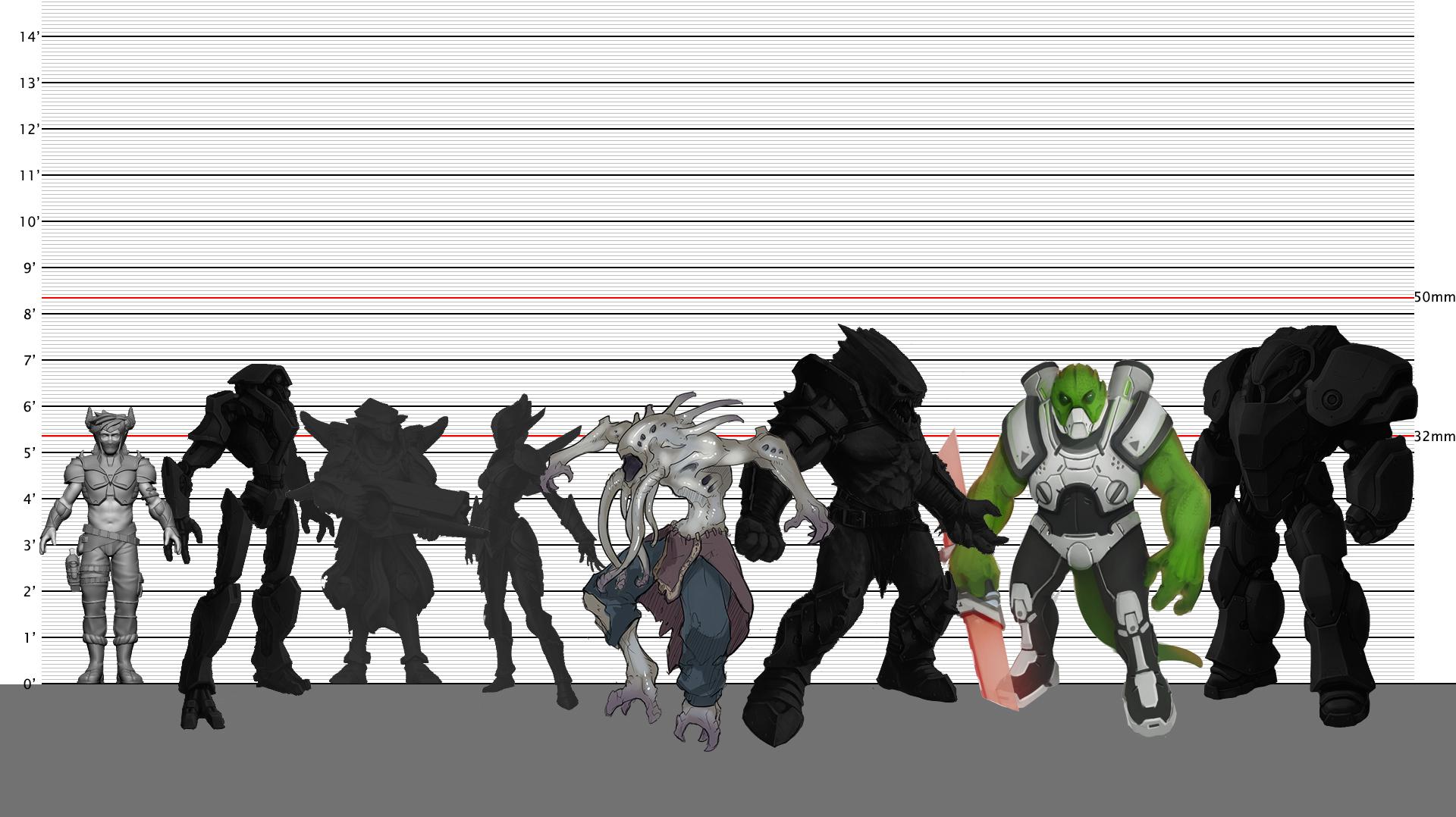 Left to Right: Light Infantry Scout 3d (AD), Cyberoid (SE), Astaria (male), Astaria (female), Nanophage, Wyrm/Char'iza Version A, Wyrm/Char'iza Version B, Current Gen Power Armor (UR).
Left to Right: Light Infantry Scout 3d (AD), Cyberoid (SE), Astaria (male), Astaria (female), Nanophage, Wyrm/Char'iza Version A, Wyrm/Char'iza Version B, Current Gen Power Armor (UR).
|
|
This message was edited 4 times. Last update was at 2016/03/13 02:13:53
|
|
|
 |
 |
![[Post New]](/s/i/i.gif) 2016/03/13 07:34:33
Subject: [Blog] Starting a Game Company - New Designs
|
 |

Decrepit Dakkanaut
|
OK, that looks great.
The rifleman Dreadnought with dual Heavy Assault Cannons could actually stand to be larger, as the cockpit looks a little small, even if you assume primarily female pilots. Also, the mecha needs more substantial feet, as the ground pressure looks way too high for they sort of game you're making. And the Assault Cannon barrels are way too large unless they are grenade launchers / mortars.
|
|
|
|
 |
 |
![[Post New]](/s/i/i.gif) 2016/03/13 09:42:52
Subject: [Blog] Starting a Game Company - New Designs
|
 |

Thermo-Optical Spekter
|
Looking quite good, 4 meters for the top height of a humanoid sized mech is what my belief is for the limit is for such vehicles.
I tend to want them on 2,5 - 3 meters but 4 is my top limit.
|
|
|
 |
 |
![[Post New]](/s/i/i.gif) 2016/03/13 16:15:34
Subject: [Blog] Starting a Game Company - New Designs
|
 |

[DCM]
.
|
Loving everything so far - and really loving that you've got a vision and are sticking to it, with tweaks were appropriate and necessary!
|
|
|
 |
 |
![[Post New]](/s/i/i.gif) 2016/03/13 17:20:05
Subject: Re:[Blog] Starting a Game Company - New Designs
|
 |

Infiltrating Prowler
|
 JohnHwangDD wrote: JohnHwangDD wrote:... the cockpit looks a little small, even if you assume primarily female pilots. Also, the mecha needs more substantial feet, as the ground pressure looks way too high for they sort of game you're making. And the Assault Cannon barrels are way too large unless they are grenade launchers / mortars.
The size is a rough approximate, it will be adjusted once we finalize the designs. Unfortunately mecha will be focused on later, not in the beginning. The focus will be on the various infantry and power armor but we want to keep in mind the mecha sizes as we continue to test and design.
For the cockpit size we started with Air Force height and weight requirements for their pilots which are 65"(5'5") - 77"(6'5") tall, 34"(2'10") - 40"(3'4") tall when sitting. They have to weigh 160-231 pounds, depending on their height. The Air Force cockpit is smaller than what we've done for the mecha. We also combined Air Force cockpits sizes and accommodations with the size and design of Japan's Kuratas robot. That was at least how we initially came to approximate sizes we have now.
Here is another mecha concept that was similarly based on that Kuratas core. Not sure which direction or what we wil do until we finalize more of the infantry and armor designs to integrate.
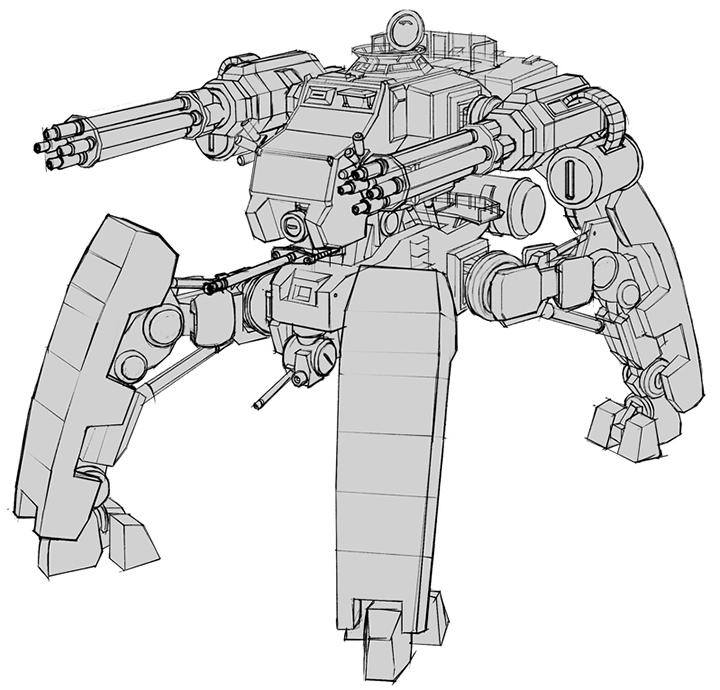
The barrels are definitely too large for me, it is one of the changes we'll be looking at. I believe the original design they were plasma/laser cannons based on the size of a GAU-8 30mm rotary cannon mounted on the A-10 Thunderbolt II. They were a laser/plasma design that rotated the barrels to prevent issues with overheating the barrels and weapon. We may be looking at arms with hands and utilizing more modular mounted vehicle weapons instead.
The feet are bigger but it is hard to tell since I have everyone standing in front, so you don't see the side angle as much. All that is visible of the talon parts to spread weight distribution of the foot and balance stabilizers, so it tends to look like crow feet.
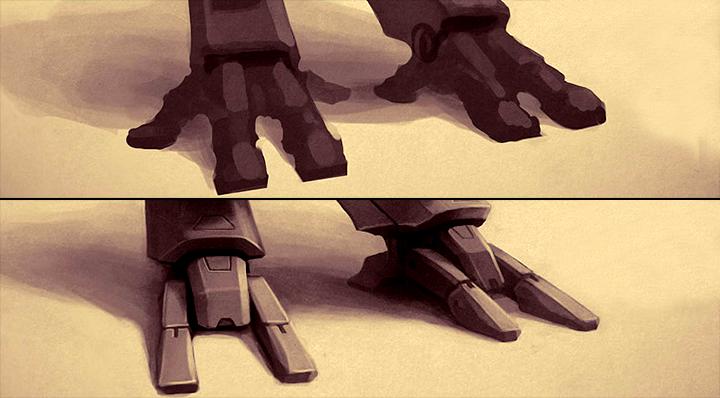
We haven't decided on what we'll do for the feet. I'm a fan of tracked, wheeled style for movement but I also like traditional blocky stompy feet. It will most likely come down to the role that the mecha play in combat and the mobility of them compared to infantry and power armor.
|
|
|
 |
 |
![[Post New]](/s/i/i.gif) 2016/03/13 18:26:47
Subject: [Blog] Starting a Game Company - New Designs
|
 |

[DCM]
.
|
I prefer stompy feet over tracked mechs all day every day! 
|
|
|
 |
 |
![[Post New]](/s/i/i.gif) 2016/03/13 19:26:44
Subject: [Blog] Starting a Game Company - New Designs
|
 |

Decrepit Dakkanaut
|
OK, it was a little hard to tell for sure, thanks for clarifying.
Also, agree with Alphy that feet >> trax.
|
|
|
|
 |
 |
![[Post New]](/s/i/i.gif) 2016/03/13 20:08:36
Subject: Re:[Blog] Starting a Game Company - New Designs
|
 |

Infiltrating Prowler
|
STARTING FROM SCRATCH
While I'm in a holding pattern waiting to hear from production, artists and editor... I like to take a break from writing and do a little creative exercise that I call "Scratch Sessions".
It is near impossible to create a game in a vacuum without a conscious or even subconscious interference from outside influences. That means that although a rules set or even history might seem to be unique and different, chances are it has aspects from other systems already. There is nothing technically wrong with that but I want to be sure that I'm not creating a reskinned clone and that my game designs meet the goal of the project.
I will either take my notebook or open up a fresh document and start creating a new system from scratch. I don't mean throw out all the work you've done, this is more of a creative exercise to make sure I've covered all the aspects I'm looking to create. Is there some method to simplify a mechanic or maybe I found a need to add a new mechanic. Time to start theory crafting.
ATTRIBUTES
I have to figure out how I want the individual units and fireteams to accomplish or determine that they succeeded with an action. The most common method is to create attributes that are assigned values, those values help determine if you succeed or fail.
There should be a difference in movement between someone in light armor, heavy armor or power armor. If this was an RPG movement is usually determined through a formula utilizing various physical attributes like strength, dexterity or some based on racial. I know that I want units to have the ability to move at a normal speed, sprint, slower movement for cautious movement. So for now we know we need the following attributes.
MOV (Movement) : This attribute is fairly self explanatory. The value determines how far a unit will move in inches.
WND (Wound) : This attribute is also self explanatory. The value determines how much damage a unit can take before it is considered unconscious, incapacitated or dead.
There are different ways to do attacks for units. Each unit could have specific attacks or 1-2 attack values which effect attacks. For a simplified method one attack value could represent the units ability and proficiency to deal damage with ranged, melee and other weapons. Although it simplifies things, it doesn't create a lot of differences between units. I would like one unit who is better with ranged attacks but may be weaker at close range. I also want thrown weapons or physical attacks to not simply just be based on a weapon stat.
We also have Psionic abilities to consider. Psionic powers aren't simply extensions of ranged/melee attacks. They aren't utilized like Magic to simply throw a fireball or do a different attack. Some of the things we want psionics is similar to buff/debuff, create different types of movement as well as possession/mind control. In a fireteam of 3-4 units, you could choose to have the units simply shoot or you could have two Psions focus to boost the attack or defense of a focused target. Some units could get different types of movement like "Blinking" which lets them basically teleport to point A to B. This is useful for bypassing terrain like walls or moving from inside a building to outside as well as bypassing or limiting the opponents ability to have responsive fire. Having a psionic user also means those fireteams have less options for weapons than a standard unit.
For now we'll start with the following Attributes which will allow different units to be more defined for the roles they are intended.
RNG (Range Skill) : The range skill determines the ability to utilize ranged weapons. Ranged weapons can include rifle, sniper rifle, machine gun.
CQC (Close Quarters Combat Skill) : The Close Quarters Combat skill determines a units ability to utilize close range weapons and fighting styles. Close Quarter weapons could be melee weapons like swords, knives or even hand to hand combat.
PHY (Physical Prowess) : The Physical skill determines the physical attributes of a unit like strength, dexterity, stamina and reaction. It can be used to throw something accurately like a grenade, or dodge an incoming attack or properly land during a combat drop.
MEN (Mental Power) : Mental Power is what represents a units mental attributes like intelligence, wisdom, courage under fire. It can be used to maintain fireteam stablity, not run away from combat as well as how strong psionic abilities and powers can be used or defended against.
ARM (Armor Value) : Armor Value determines just how powerful and how much protection a unit has.
Armor is an interesting attribute. It can be used simply to subtract a value from the total damage dealt. It also also simply be used to determine what weapons can deal damage. For example if it is an Armor Value of 2, then only weapons then only Type 2 weapons or more are effective so a pistol and knife may do no damage. I am not usually a fan of the simplified method.
I believe in modern warfare every weapon is created to maximum lethal capacity. In most cases all weapons are lethal despite armor unless you start mixing in heavy vehicles so isn't technically a necessary stat so it could be stripped entirely. It however can also provide a good balance to limit luck, making rolls not completely luck but stabalizing the balance between luck and skill within a game. One method is to use it to determine saving rolls, which can be used to limit damage dealt by someone who is on a lucky rolling streak. For now we'll keep it in place unless it proves to be too bulky.
DICE AND VALUE
Now that I figured out my base attributes. I need to figure out what values to give them and how they'll determine successes. One base staple is D6, almost everyone has them and they are easy to use and different ways to use them. Without introducing any modifications to target numbers, one simple method to utilize and determine successes is to roll greater than a target value. The attribute can determine what that target value is or it can simply indicate how many dice to roll. It really depends on what you want to accomlish and their relation to other abilities, skills and weapons. If the value determines rolling more dice then the base probability below gets modified depending on how many dice you roll.
Roll ≥ 1: 100% | Roll > 1: 83% (critical failure on 1)
Roll ≥ 2: 83% | Roll > 2: 66%
Roll ≥ 3: 66% | Roll > 3: 50%
Roll ≥ 4: 50% | Roll > 4: 33%
Roll ≥ 5: 33% | Roll > 5: 16%
Roll ≥ 6: 16% | Roll > 6: 0% (critical succcess on 6)
NOTE: This is a simplified version of probability for dice. There are specific formulas for probability and generators which show you the amount based on the type of dice and how many you want to roll.
For board games I tend to favor and like D6. There isn't a lot of various between skills, characters and actions. There is a different type of momentum for board games that tend to favor go big and taking chances. When you fail it can have a big impact. For a skirmish game I would want there to be less reliance on rolling, with more of a emphasis on deployment, movement and proper application of skills combined with rolling. I want there to be a bigger variety between units so I will start with D10.
Roll ≥ 1: 100% | Roll > 1: 90%
Roll ≥ 2: 90% | Roll > 2: 80%
Roll ≥ 3: 80% | Roll > 3: 70%
Roll ≥ 4: 70% | Roll > 4: 60%
Roll ≥ 5: 60% | Roll > 5: 50%
Roll ≥ 6: 50% | Roll > 6: 40%
Roll ≥ 7: 40% | Roll > 7: 30%
Roll ≥ 8: 30% | Roll > 8: 20%
Roll ≥ 9: 20% | Roll > 9: 10%
Roll ≥ 10: 10% | Roll > 10: 0%
On the surface there isn't a lot of difference between having a value of 2 or 5 that you have to roll greater than or equal to. With D6 rolling ≥ 2 is 83% success probability with ≥ 5 being 33%. With a D10 ≥ 2 is 90% and the equivalent to a 5 on D6 being 9 on a D10, so rolling ≥ 9 is 20%. There ends up being roughly a 10-13% difference depending on how you translate one version to the other. I would like there to be a difference between unit levels and experience so that a green soldier has a different rating than an experienced veteran. However I also want there to be different degree's of a green soldier transitioning to an experienced soldier.
≥ 10 (10%) - Untrained/Unskilled: There is a difference between someone who is untrained and unskilled vs someone who has training but not military experience. Since we have rules for "neutral" NPCs like civilians which can be possessed or become an enemy we have this level. Someone who is untrained would have the ability to inflict harm and succeed but not by a large amount.
≥ 9 (20%) - Green Recruit: There are multiple levels of inexperienced units. This represents new soldiers fresh from boot camp but not necessarily integrated into an effective unit.
≥ 8 (30%) - Green Rookie:
≥ 7 (40%) - Veteran:
≥ 6 (50%) - Grizzled Veteran:
≥ 5 (60%) - Elite:
≥ 4 (70%) - Experienced Elite:
≥ 3 (80%) - Ace:
≥ 2 (90%) - Demi-God:
≥ 1 (100%) - God:
CONTESTED ROLLS
I have a rough idea of values and how I want them to interact and translate into the units. From that I can create baseline units with stats and modify their Battle Value for each unit depending on their type. An Experienced Elite is 50% more effective than a Green Rookie, so they would cost twice as much as a normal Green Rookie. A Veteran isn't too much difference between a Green Rookie, so it may only have a 10% increased Battle Value. It however isn't just as cut and dry as that. The Green Rookie might be better at Close Quarters Combat compared to Ranged than the Veteran, but the Veteran is better at Ranged but not at CQC. If you are going to utilize CQC more, then going cheaper is better. You have to look at what equipment units have access too and their roles so Battle Value will have to be adjusted. It however makes it a good starting point.
I do not prefer games where someone rolls successs, the opponent rolls saves and that determines what gets hit and takes wounds. I like combat to be more like an action movie and less like a chess game (in refering to combat resolution). There is a difference between active attack and snapfire/reactive attacks as well as overwatch. Combat is fluid and rarely is one side just holding doing nothing, while they are under fire (unless it is suppression). That is why the active player can choose to activate 1-3 units (units are individual characters or a fireteam), then it will alternate to the next player. In this essence there is action/reaction to not simply movement, but deployment and attacks as each side determines what to move and where. Some units might be able to be activated more than once, while others in order to activate a second time could mean giving them fatigue. Is that risk worth the reward, it can be to prevent a unit from being flanked.
This allows players to have interaction with each other, not only through short turn sequences allowing them to act to players moves and attacks but through contested rolls.
That is it for this scratch session. Whether we implment the above, integrate it or only take certain aspects depends on numerous factors. In some instances we've come up with some great mechanics, although it doesn't fit the particular game style we're creating. For example we have one game method that all units are unknown unless within LoS of an enemy unit and/or sensor. Initial deployment is nothing but tokens meant to show enemy locations as blips. Most blips represent one unit but there are a couple that could be multiple units or multiple blips may actually be one unit. Each token is assigned in the Army list what they represent. Your opponent could have a basic idea of what you are bringing based on your miniatures on the sideline but they won't know which token is that unit until they engage. Although it is a fun mechanic it doesn't suit the enivonrment for Code Zero. We've instead move that to a different project called Tact-Ops for now.
|
|
This message was edited 4 times. Last update was at 2016/03/14 06:22:20
|
|
|
 |
 |
![[Post New]](/s/i/i.gif) 2016/03/14 11:19:42
Subject: [Blog] Starting a Game Company - New Designs
|
 |

Thermo-Optical Spekter
|
Funny thing you mentioned armour, I am toying with armour myself this morning
There are 4 main schools of armour
The preventive armour were the hit either can penetrate or have no chance at all
The Buffer armour were the armour subtracts from the wounds scored
And the random armour were each armour point rolls a dice that has the chance of cancelling the hit. (usually found in boardgames)
And the roll to save armour were armour must meet a roll to save the target from the weapon
Once mighty but fallen to obscurity is the ablative armour as seen on battletech, centurion I think? ( was that the name of that the game with grav tanks) and that alt history planes game. were armour is points (functioning hike hitpoints for each individual location really) that prevents damage from hitting the softer inner parts.
The above are sometimes mixed to give more variable results, 40k for example has roll to save, mixed with preventive armour.
Personally I am stuck in choosing what armour method I want for my games I feel buffer or random would be the way but buffer with random is intriguing too and I have to decide this before I finalize everything else.
I also toyed a lot with preventive armour I think its a great mechanism, but I feel I need more practice with it.
|
|
|
 |
 |
![[Post New]](/s/i/i.gif) 2016/03/14 13:40:15
Subject: Re:[Blog] Starting a Game Company - Scratch Session
|
 |

Infiltrating Prowler
|
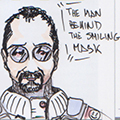 PsychoticStorm wrote: PsychoticStorm wrote:Personally I am stuck in choosing what armour method I want for my games I feel buffer or random would be the way but buffer with random is intriguing too and I have to decide this before I finalize everything else.
I also toyed a lot with preventive armour I think its a great mechanism, but I feel I need more practice with it.
Preventive armor was something that I found to create a difference in RPGs, used to promote different ways to resolve resolution than simply combat. It makes sense to a degree that is how armor should work realistically. As an example if someone was in protective armor, typically bows/arrows and melee weapons do no damage to the user. Guns above certain calibers with normal ammo would. The issue though it becomes a "why would you ever bring a bow user then? In games with magic or alternate means to resolve combat situations, it promoted a method to think outside of the box. That doesn't mean it can't be used in a miniatures game situation but there has to some reason to bring someone with a less powerful weapon vs just stacking defense.
I can see a miniatures skirmish game using preventive effectively if the main focus is around deployment, then maneuvering and flanking. Maybe one method this can employ is a type where psionic/magic users have abilities that negate armor (mind attacks as example). Although they have lower powered weapons that don't penetrate armor, their abilities do. Maybe they have to attack with an ability which negates armor for X turns, then use their weapons. Their armor negates bows/basic knife weapons so an opponent needs someone with guns to take them out, forcing them to take a mix group of units. Then it becomes a matter of maneuvering properly. It still needs a lot of work but its a rough example. But yeah it was easier in RPGs because you could revert to charisma, traps, other non-combat skills to get around situations where traditionally in miniatures games it is combat.
It really depends on play testing. There have been some mechanics and games where armor and savings roll bog things down and sometimes it is better to simply remove it. If I was a larger company with more employees and focusing full time on games, I'd probably do more testing to try to remove the mechanic entirely at least for modern or scifi miniatures skirmish games. That however means making sure balancing is dialed in near perfectly. Otherwise armor is a good balance to help counteract randomness and give a buffer to balancing stats.
I have toyed back and forth, instead of having armor be a a save/cancel a hit, having it be essentially an extra wound. Someone with 0 armor is basic clothes, light armor 1, medium armor 2, etc. If they take a hit, it provides them an extra wound instead to eliminate rolling. But then the question becomes why not just give them the extra hit point and remove armor entirely. That was mostly because I was trying to employ a mechanic to fall back and have a doctor heal or engineer repair armor. I think it would probably make more sense in a mecha/vehicle based game instead of one centered around infantry.
---------------------
Here are some weapon concepts designs. Along with the size charts I've been working on, I have to figure out which weapons will carry across the game and which ones won't. One of the issues when mixing in different game designs from another project is to ensure that the weapons fit into the universe. We have to determine what ones would work out with our current designs.
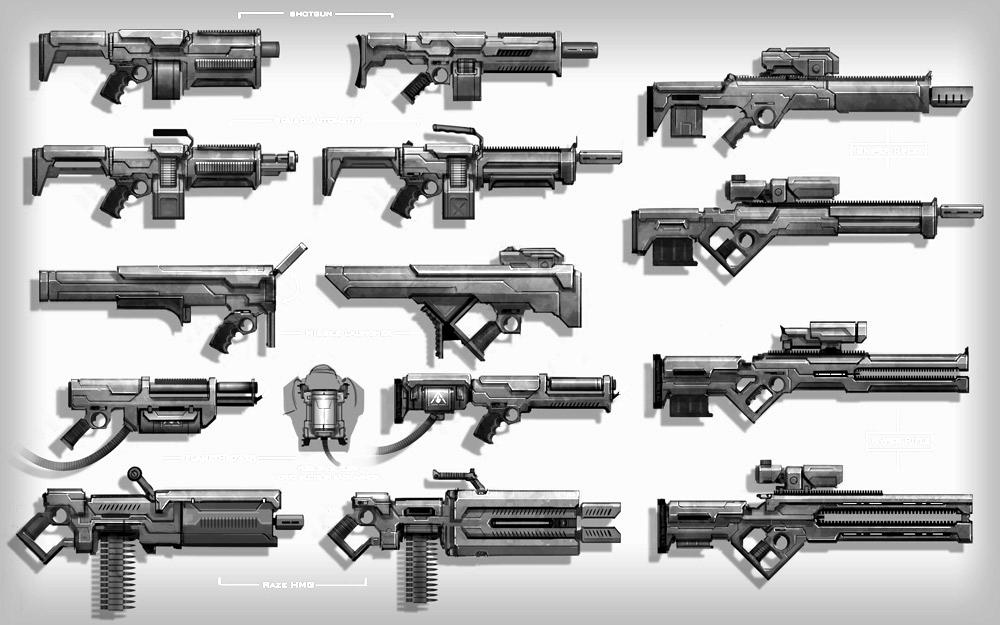
These were for a more primitive slave caste, reconstructing crude weapons from what was cobbled together.
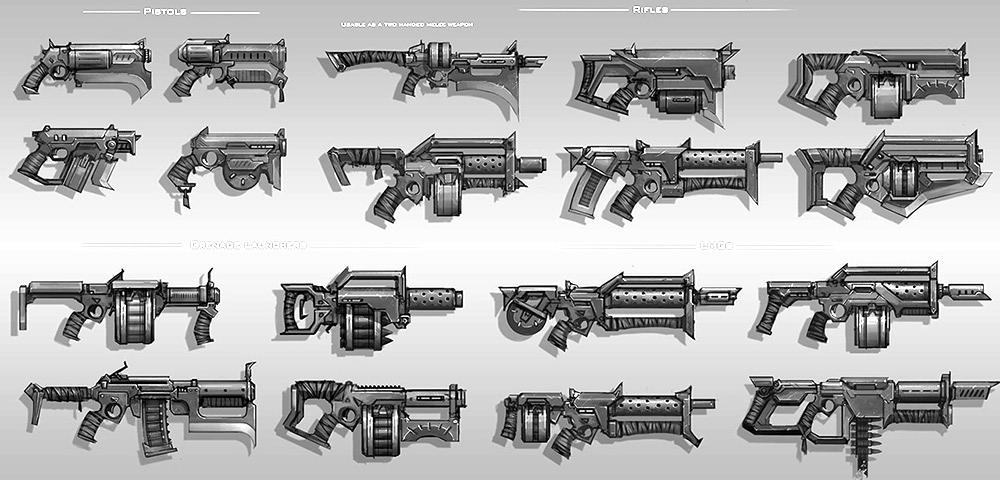
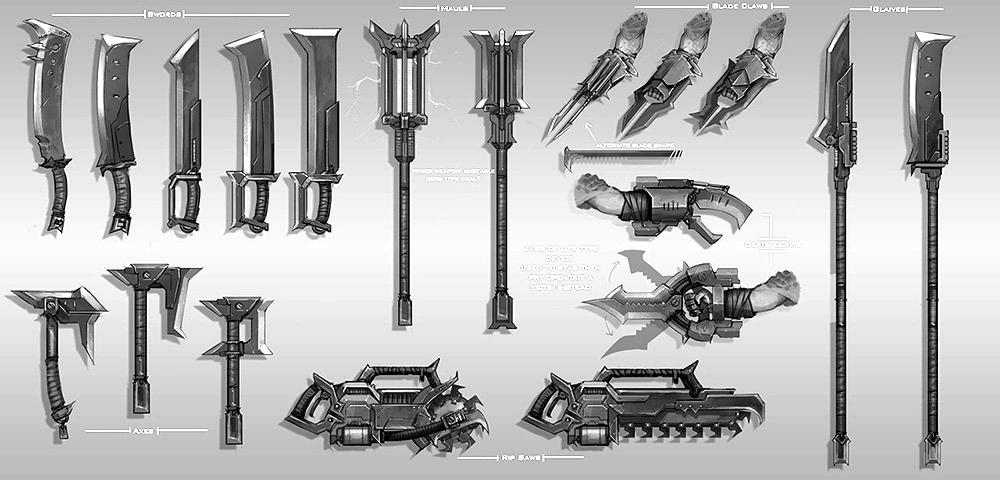
These were designed with a more alien scifi style instead of based on traditional weapons.
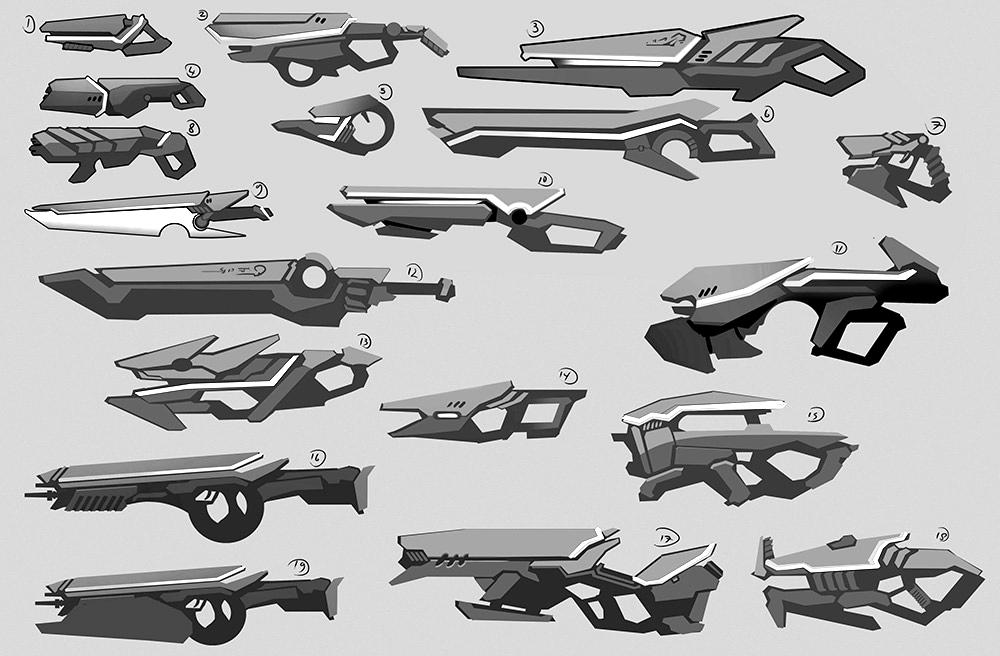
|
|
|
 |
 |
![[Post New]](/s/i/i.gif) 2016/03/14 14:34:47
Subject: [Blog] Starting a Game Company - Scratch Session
|
 |

Thermo-Optical Spekter
|
Well you could use armour as additional hit points per hit but that would just make it a buffer armour.
Buffer armour can be used as a variant preventive armour thinking about it, cutting different amount of damage per damage type/ weapon grade.
Actually that could be an interesting solution to my issues.
|
|
|
 |
 |
![[Post New]](/s/i/i.gif) 2016/03/16 23:03:51
Subject: Re:[Blog] Starting a Game Company - Scratch Session
|
 |

Infiltrating Prowler
|
Unfortunately still in a holding pattern. There was an error with the STL files, they were originally sized 35mm from the base of the feet to the eyes. We were talking about sizes when I stated I wanted them to be 32mm. Then we compared some other miniatures and sizes, one which was 35mm and I think somehow it got lost in translation. It was partly on me since I did approve them and the sample sheet does show 35mm block they used for sizing. Thankfully 3d printing wasn't finished and casting hadn't started yet so we put a pause on that. They are being resized and then I'll have to have new masters printed out, which delays things a bit more than I would have liked. At least there is a understanding of what I'm looking for so future issues should be avoided.
In the meantime I decided to mess around with layout and formatting for the initial rulebook for an Alpha release. I'm still messing around with fonts, sizes, layout, and colors. Decided instead of a complicated graphic for the borders and details that I'll start out simple with some clean lines. The font size isn't too important as it'll be on PDF initially anyways so there is always a way to zoom in.
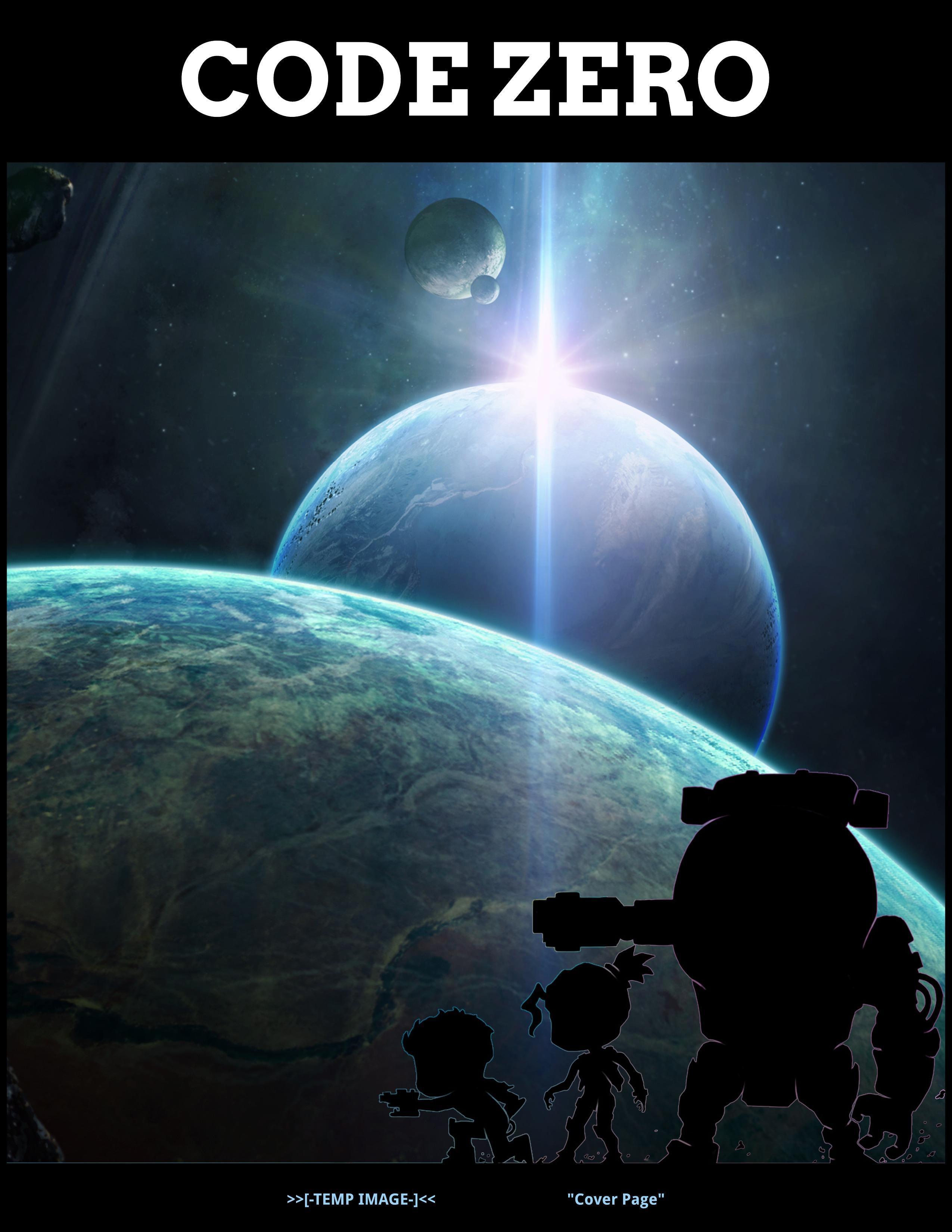
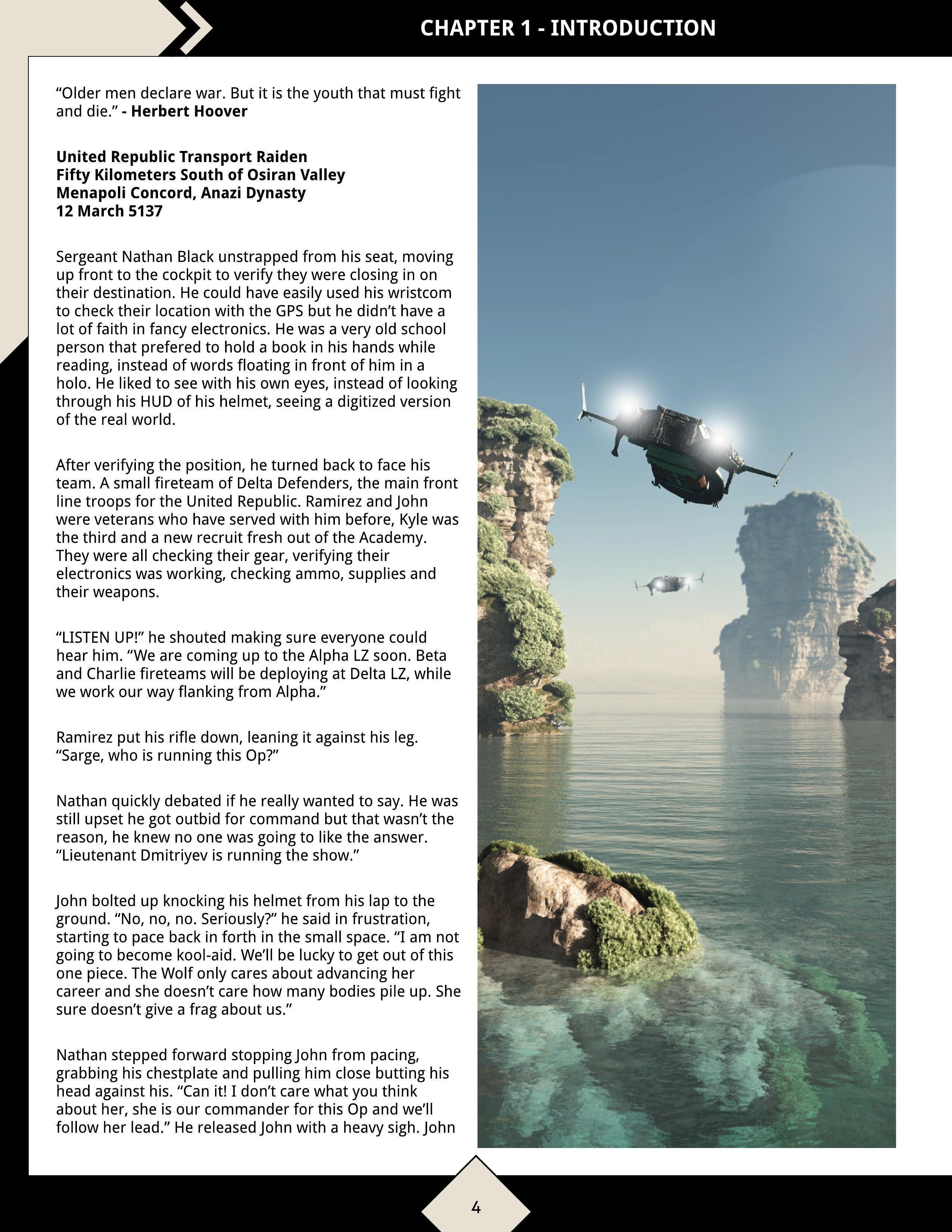
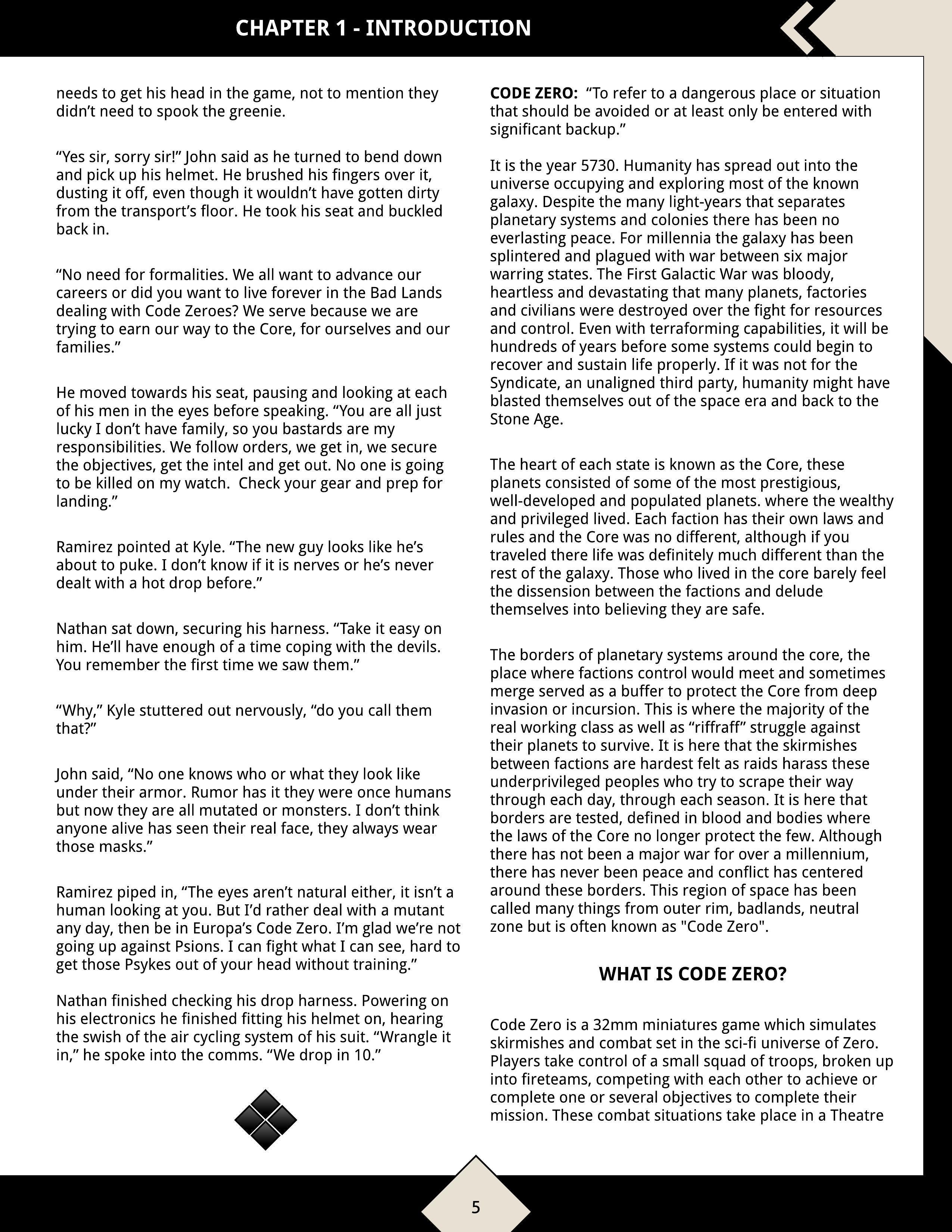
|
|
This message was edited 2 times. Last update was at 2016/03/16 23:05:05
|
|
|
 |
 |
![[Post New]](/s/i/i.gif) 2016/03/29 20:54:09
Subject: Re:[Blog] Starting a Game Company - Trying New Things
|
 |

Infiltrating Prowler
|
In our play-testing with a new playgroup we encountered an issue that has not been until now. Most of the testers we've been playing with have been miniatures gamers or at least those that have had experience with miniatures games. This new group was mostly board gamers, some TCG players but have had no real experience with miniatures games. They unfortunately had trouble with one of the basic concepts when dealing with Head to Head roll-offs. When there are multiple units that are acting at the same time, there is a contested roll that is made by both players to see how the actions resolve.
For an example we'll say the following players had two characters with the following attributes:
Player A - Ranged: 6, Physical: 7
Player B - Ranged: 7, Physical: 4
The base to hit number a player wants to roll greater than or equal in order to succeed is based on their skill they are using. Then if there are any modifiers, depending on range or abilities, they would modify the target to succeed. For simplicity we'll say there are no modifiers in play.
The active Player A is shooting at Player B, so he would be rolling 4d10 trying to roll a 6 and higher to succeed based on his Ranged skill. The reactive Player B decides to respond by shooting back so would roll 2d10 trying to roll a 7 or higher to succeed. Both players roll their dice, first determining how many success were rolled.
Player A rolled 4, 2, 7, 9
Player B rolled 3, 8
The results 3 and 4 don't succeed so we ignore them. That leaves Player A with 2 successes and Player B with with 1 success. We determine if any results cancel each other. Successful rolls higher than the other players success could cancel them out. Starting with the lowest success, Player A's 7 is canceled by Player B's 8. Then Player A's 9 cancels out Player B's 8 resulting in Player A scoring one hit against Player B. Player B would roll an armor save to determine if he takes a wound or not.
Player A rolled 4, 2, 3, 8
Player B rolled 3, 8
The results 2, 3, 4, and 4 are not successes so we ignore them. Player A and Player B both have an 8, since none is higher than the other they do not cancel and are both considered a hit. Player A ends up shooting Player B with one hit and vice versa. They both now roll an armor save to determine if they take a wound or not.
Trying New Things
You should never be afraid to try out new mechanics or attempt to simplify things. The issues we had resulted in a discussion about whether we to simply try to explain it better and make the rules clearer with examples or if we should change the mechanics for those situations. Ultimately we have to decide do the rules still meet the requirements for our game.
In one aspect for miniature gamers it should be fairly initiative and easy to transition too. After doing it a few times it is easy to get the hang of it. However do we hurt ourselves by simply accepting that instead of finding a new solution. The end result was us testing a new mechanic to simplify things and streamline them a bit more.
We have been trying to stay away from custom dice but this made us revisit a design we had tabled early on. Taking a page from XWing and are utilizing 2 different sets of dice, we created Red d10 for attack dice and Blue d10 for defense dice. This does mean we have to change some of the attributes.
For an example we'll say the following players had two characters with the following attributes:
Player A - Ranged: 4, Physical: 5
Player B - Ranged: 5, Physical: 2
The active Player A is shooting at Player B, so he would be rolling 4d10 attack dice. The reactive Player B can choose to dodge with 2d10 blue defense dice (physical trait) or attack with 2d10 red attack dice (ranged / 2). He chooses to also use attack dice. Modifiers now operate a bit differently, instead of modifiers changing the 'target to hit' it could subtract or add dice to their base dice pool. So if Player A was in optimum range, he might be rolling 5d10 instead. For the example though we'll assume no modifiers are applied.
Player A rolled 1 shield, 1 energized, 2 hits
Player B rolled 1 shield, 1 energized
Immediately there is no checking to hit or having to figure out which success is higher than another. It is immediate to see 2 successful hits. This does change mechanics a bit. For example Player B has a psionic ability, "Premonition" which previously would let him reroll a failed roll. In this aspect we modified it to utilize the "energized" dice facing, which he can use to change the results of one of the hits to something else. He couldn't utilize it to change a critical hit though.
We still haven't decided if we'll be switching to that. There are pro's and con's by doing it. It however does provide other ways to apply mechanics like how to do something 'else' with Psionics without it simply being a buff/debuff or an attack power. Trying to find the right balance of dice, what is on each facing will also be a new thing for us.
|
|
|
 |
 |
![[Post New]](/s/i/i.gif) 2016/03/29 21:01:39
Subject: [Blog] Starting a Game Company - Trying New Things
|
 |

Decrepit Dakkanaut
|
If you are making a game, Custom dice all the way!
I really love the Super Dungeon Explore / Conan dice model, of 3 tiers giving results of No to 4 pips, with a "special" face. That's a nice numerical system with a lot of granularity.
The alternative is Command and Colors a la Battlelore / M44 / Battlecry, with special symbols on each facing (which are really 0-0-0-retreat-hit-special).
|
|
|
|
 |
 |
![[Post New]](/s/i/i.gif) 2016/03/29 21:24:34
Subject: [Blog] Starting a Game Company - Trying New Things
|
 |

Infiltrating Prowler
|
 JohnHwangDD wrote: JohnHwangDD wrote:If you are making a game, Custom dice all the way!
I really love the Super Dungeon Explore / Conan dice model, of 3 tiers giving results of No to 4 pips, with a "special" face. That's a nice numerical system with a lot of granularity.
The alternative is Command and Colors a la Battlelore / M44 / Battlecry, with special symbols on each facing (which are really 0-0-0-retreat-hit-special).
Early on we did entertain something like SDE/Conan with different types of dice. Red was ranged actions/abilities, blue for psionic actions/abilities and green for physical actions/abilities. We started with D6 but couldn't find a right balance for how to determine successes and head to head resolutions. We started with a certain number of pips, adding those up could have different results. There were other designs on the other dice facings that did other things. Although great for a board game, it provided a bit more randomness than we wanted with the dice.
We then switched to d10 and a more traditional system. That has worked out well. But the goal isn't to just simply make another skirmish game. I want to aim for people like my wife, who likes board games but not so much miniatures games. She has actually enjoyed playing our game, but I think because she started at the ground up instead of just starting from scratch. After this last group brought up some questions and concerns we took a second look at things like what makes XWing popular and why do some people like board games with miniatures but not so much war games.
Oddly one of the things that our groups didn't mind in RPGs, they did mind in miniatures games and that was bookkeeping. I mean figuring out to hit, modifiers, what to roll. That is probably due to the fact that in a RPG group, players normally ask a DM what they are rolling who could typically say, "Dexterity minus 3" or something like that. In what are viewed more competitive type games, they don't like to have to figure those things out. They just want to know, what dice and how many do I roll, then if they can see results clearly.
This does resolve another issue we were working on which was how to handle psionic, mutant and cybernetic abilities/powers. Originally these were skills that some units have access too. It isn't something they can use all the time. We have switched from turning a card sideways when it is used, returning it back during start of next turn. We've tried various skill decks which was a microgame in itself. Now we can just have what would normally be blank sides on the d10, be something like "energized" or "shield" trigger or be used for other abilities.
|
|
This message was edited 1 time. Last update was at 2016/03/29 21:47:15
|
|
|
 |
 |
![[Post New]](/s/i/i.gif) 2016/03/29 21:41:14
Subject: [Blog] Starting a Game Company - Trying New Things
|
 |

Thermo-Optical Spekter
|
I can relate to the struggle I have way too many studies for custom dice on my design dossier, not happy with most of them.
|
|
|
 |
 |
![[Post New]](/s/i/i.gif) 2016/03/29 21:56:14
Subject: [Blog] Starting a Game Company - Trying New Things
|
 |

Decrepit Dakkanaut
|
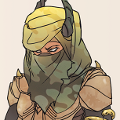 Dark Severance wrote: Dark Severance wrote:Early on we did entertain something like SDE/Conan with different types of dice. Red was ranged actions/abilities, blue for psionic actions/abilities and green for physical actions/abilities. We started with D6 but couldn't find a right balance for how to determine successes and head to head resolutions. We started with a certain number of pips, adding those up could have different results. There were other designs that did other things. Although great for a board game, it provided a bit more randomness than we wanted with the dice.
I want to aim for people like my wife, who likes board games but not so much miniatures games. She has actually enjoyed playing our game, but I think because she started at the ground up instead of just starting from scratch. After this last group brought up some questions and concerns we took a second look at things like what makes XWing popular and why do some people like board games with miniatures but not so much war games.
Oddly one of the things that our groups didn't mind in RPGs, they did mind in miniatures games and that was bookkeeping. I mean figuring out to hit, modifiers, what to roll. That is probably due to the fact that in a RPG group, players normally ask a DM what they are rolling who could typically say, "Dexterity minus 3" or something like that. In what are viewed more competitive type games, they don't like to have to figure those things out. They just want to know, what dice and how many do I roll, then if they can see results clearly.
This does resolve another issue we were working on, which is psionic, mutant and cybernetic abilities/powers. Originally these were skills that some units have access too. It isn't something they can use all the time. We've switched from turning a card sideways when it is used, returning it back during start of next turn.
We've tried various skill decks which was a microgame in itself. Now we can just have what would normally be blank sides on the d10, be something like "energized" or "shield" trigger or be used for other abilities.
IMO, having dice by attack type vs Weak / Average / Strong is probably where your d6 dice thing fell apart. Every psionic attack increments as 1x, 2x or 3x. Every ranged attack is 1x, 2x or 3x. Versus the granularity of WWW vs AA vs S. Or AW vs AS.
That outreach to casuals / newbies is a very big part of the reason why KOG light is the way that it is. 
KOG light also limits bookkeeping and state tracking for very similar reasons. People are generally honest and don't like making mistakes. The game should be self-evident, with fewer questions to ponder, and less ambiguity in general. All non-refereed games have this issue, and the higher the game complexity, the more likely issues crop up.
You don't use the copyrighted and trademarked "tap" terminology, do you? 
I assume you've played Legendary / Sentinels, right? Deckbuilding can basically be an entire game. Now that's fine, if you want. There is some argument that you expand the deckbuilding concept and put numbers on the cards like the 40k CCG / Sentinels / Malifaux for a "diceless" game.
|
|
|
|
 |
 |
![[Post New]](/s/i/i.gif) 2016/03/29 22:37:40
Subject: Re:[Blog] Starting a Game Company - Trying New Things
|
 |

Infiltrating Prowler
|
 PsychoticStorm wrote: PsychoticStorm wrote:I can relate to the struggle I have way too many studies for custom dice on my design dossier, not happy with most of them.
Since our skirmish game rules will be available for free, we really wanted it to simply be download rules, get dice, get miniatures and play the game. I was trying to stay away from having someone have to purchase "custom dice", they could technically just use their miniatures, dice and our rules (for testing at the very least). Sure I could just say 4-7=hit, 10=critical hit, 1-3=energized and 8-9=shield, if someone didn't want to use the custom dice.
 JohnHwangDD wrote: JohnHwangDD wrote:...
You don't use the copyrighted and trademarked "tap" terminology, do you? 
I assume you've played Legendary / Sentinels, right? Deckbuilding can basically be an entire game...
Hehehe, correct we do not use the word tap. My main background is from World of Warcraft TCG which was 'Exhaust' instead of tap, which now HEX uses that term. I also used to play Magic so I'm aware of what WoTC has copyrighted and trademarked in that aspect. That was why I said "turn the card sideways", we also did flipping the card over.
Yes I am definitely familiar with Deckbuilding games. I really enjoy deckbuilding games but I know not everyone likes them. There is a certain strategy and understanding that some players need to understand to play them. Casual players don't really get some of those and the differences between an experienced DBG vs a casual DBG can quickly become evident. That gap can be difficult to close, which is why even though I enjoy them, I don't want that to be a necessary component to the skirmish game.
Now one of our board games does have a type of deck building, but it isn't a game in itself. It is a precreated skill/powers deck so it is more the motions of understanding deck building. The player draws a hand of 5, they can keep 1 in reserve but anything not used at the end of the main phase gets discard to the graveyard. At the start of turn, they draw back up to 5 cards in the hand or 4 if they kept 1 in reserve. It is more to understand what skills/powers to hold back, when to dump and timing on reshuffling the graveyard to get access back to those skills.
|
|
|
 |
 |
![[Post New]](/s/i/i.gif) 2016/03/29 22:48:35
Subject: [Blog] Starting a Game Company - Trying New Things
|
 |

Decrepit Dakkanaut
|
Just checking, didn't want you to get in trouble with the big guys. 
I agree that deckbuilding games aren't for everyone, especially as it requires a deep understanding of the deck itself to play well, so the player doesn't build into a bad strategy. Or, it needs a very well-crafted deck so a new player cannot be led into building a terrible position. Not easy.
Personally, I'm happiest with cards as reference, with the caveat that ALL of the information needs to fit on the card, whatever size card it is, while the card is face-up.
I am also OK with cards for command actions a la M'44 / Battlelore. That's a good compromise, distinct from deckbuilding as such. The nice part about card commands is that they tell the player what to do right there. Clean.
____
Also, as your game rules will be free print-and-play, that also suggests d6s a la Cheapass Games.
|
|
This message was edited 1 time. Last update was at 2016/03/29 22:49:53
|
|
|
 |
 |
![[Post New]](/s/i/i.gif) 2016/03/30 18:40:15
Subject: [Blog] Starting a Game Company - Trying New Things
|
 |

Infiltrating Prowler
|
 JohnHwangDD wrote: JohnHwangDD wrote:I am also OK with cards for command actions a la M'44 / Battlelore. That's a good compromise, distinct from deckbuilding as such. The nice part about card commands is that they tell the player what to do right there. Clean.
We're trying to find a right balance for this. I am trying to have all relevant information on the main stat card for each unit. There are some different psionic abilities and equipment that can round out the units, those will probably be separate cards. Once a player knows the basic actions, moves, I'd like everything on the table to just work without need to reference the rule book. We however still want there to be a wide variety of actions and choices, not simply shoot and move.
Also, as your game rules will be free print-and-play, that also suggests d6s a la Cheapass Games.
There will be a rulebook for sale (for those that like physical books) for the actual skirmish game but that won't be for awhile. Sort of taking a lesson from Infinity in this aspect that there is a rulebook for sale, but there is also the rules online free in a .pdf format.
Here are some designs we've messed around with:
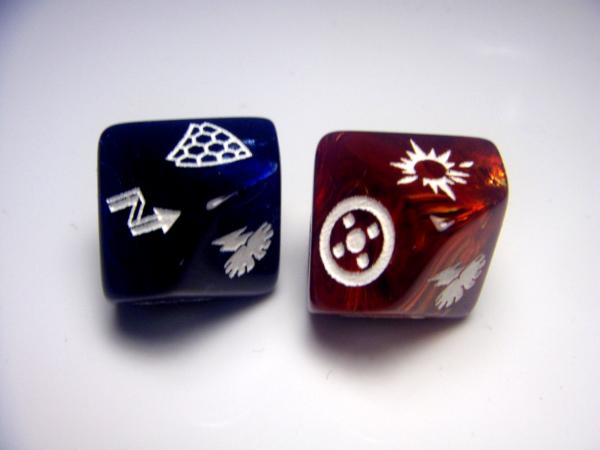

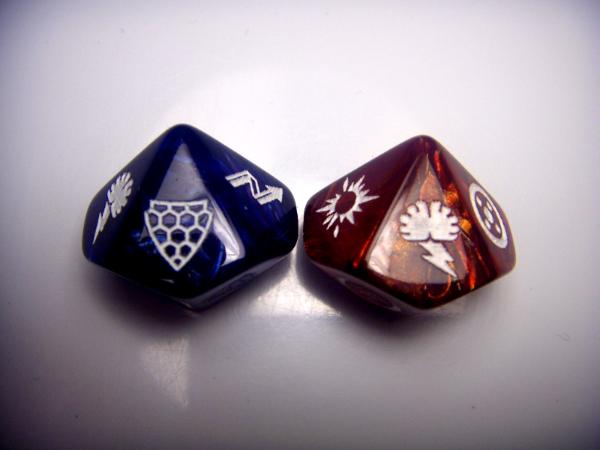
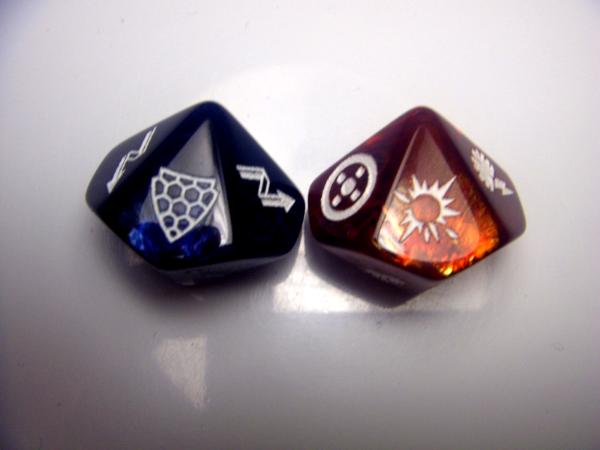
|
|
|
 |
 |
![[Post New]](/s/i/i.gif) 2016/03/30 19:07:39
Subject: [Blog] Starting a Game Company - Trying New Things
|
 |

Decrepit Dakkanaut
|
IMO, the designs are ever so slightly more ornate than what I might have expected. It's not obvious what is what, but if you only have 5 symbols, it should be OK. I'd avoid having more symbols than that to minimize confusion.
If you're doing free core rules PDF, that's fine. I mistook the free PnP intent. Sorry for confusing things.
|
|
|
|
 |
 |
![[Post New]](/s/i/i.gif) 2016/03/30 21:05:03
Subject: [Blog] Starting a Game Company - Trying New Things
|
 |

Infiltrating Prowler
|
 JohnHwangDD wrote:IMO JohnHwangDD wrote:IMO, the designs are ever so slightly more ornate than what I might have expected. It's not obvious what is what, but if you only have 5 symbols, it should be OK. I'd avoid having more symbols than that to minimize confusion.
They are still a work in progress. These were just what we prototyped with for game initial testing. We wanted the design to be scifi, familiar and we weren't sure how detailed we could get with the d10.
Currently attack dice have 4 hit (cross-hairs), 1 critical hit (circle-explosion), 3 energized (brain with lightning), 2 shield (hex shield). The defense dice have 4 shield (hex shield), 4 dodge (jagged arrow), 2 energized (brain with lightning).
We're still messing with the ratio as we determine the different things we can do with the dice so that will probably change.
Two players shooting at each other and both are rolling attack dice. Hits are obvious hits, critical are an obvious hit. Shield can negate an opponents hit but never cancels out a critical. Energized depending on the unit could simply count as a miss, but there are some abilities that could utilize it. Energized token could effect a future roll, be used for some psionic abilities to enhance/buff an attack or defense roll on another unit.
Attack dice can also be used for psionic attacks, in which energized are successful hits except for critical which works for both ranged and psionic attacks. If two players are engaged in a psionic attack, shields are used to negate successful hits. That was one reason we wanted it a bit different than a basic physical shield because it can represent psionic defense or physical defense.
Defense dice are used to physically dodge/evade physical attacks or can be used as a psionic defense. One player shooting, another player chooses to dodge instead then dodge can be utilized for dodge/evade which essentially negate hits, except for critical. If defending against a psionic attack then they would need shields to negate the successful hits. The energized are used for abilities and powers just like in the attack dice.
That is the rough explanation. We're still messing with combinations or attack, defense scenarios trying to determine how to apply them for other tests like physical skill test, armor save test and moral/leadership test.
|
|
|
 |
 |
![[Post New]](/s/i/i.gif) 2016/03/30 21:25:06
Subject: [Blog] Starting a Game Company - Trying New Things
|
 |

Decrepit Dakkanaut
|
I did not know that was a brain, to go with the crosshairs. 
For a d10 with 4 custom faces, I recommend a 4-3-2-1 distribution, as it allows you to clearly rank order the effects.
For what you are doing, is there a reason why you need to distinguish brain vs crosshairs? And why there's no knife? If not, how about:
Attack
4 - hit
3 - dodge
2 - crit hit!
1 - crit fail
Defend
4 - dodge
3 - (blank)
2 - hit!
1 - critfail
|
|
|
|
 |
 |
![[Post New]](/s/i/i.gif) 2016/03/30 22:36:46
Subject: [Blog] Starting a Game Company - Trying New Things
|
 |

Infiltrating Prowler
|
 JohnHwangDD wrote: JohnHwangDD wrote:I did not know that was a brain, to go with the crosshairs. 
For a d10 with 4 custom faces, I recommend a 4-3-2-1 distribution, as it allows you to clearly rank order the effects.
For what you are doing, is there a reason why you need to distinguish brain vs crosshairs? And why there's no knife?
The only difference between a ranged shooting attack and close quarters combat (knife) is the dice pool. Units could be more proficient at ranged than close quarters or equally trained, but their attribute would determine the base dice they would roll for their attacks. In close quarters combat, just like ranged, we are looking for hits so a crosshairs seemed a good representation for aiming.
Yeah brain with lightning to represent energized/focus. I didn't want just lightning because I didn't want it to be confuse with the evade arrow. I also didn't want to use a eye because of XWing. It can be used for psionic checks, as well as leadership checks which have a different success ratio compared to physical/weapon attacks. That was why I didn't simply use 'hit' to indicate a successful test. There are abilities which might apply it to equivalent of a hit/shield or could do something else, giving more options to a player than simply... hit, cancel hit (dodge), crit and fail.
What you suggested we sort of already for attack dice except we don't have a critical failure.
Attack
4 - hit : Hit, represents successful hits.
3 - dodge : Energized, not a dodge but used for special abilities/psionics.
2 - crit hit! : Shield, used to negate hits similar to a dodge.
1 - crit fail : Critical Hit.
The defense is a bit different. Although we could still do a 4, 3, 2, 1 distribution. We just haven't figured out if there is another application defense dice is applied to than what we currently have.
Defend
4 - dodge : Dodge, used to negate physical attacks.
3 - (blank) : 4 Shields, used to negate psionic attacks and in some ability checks.
2 - hit! : Energized, used to power special abilities/powers.
1 - critfail : Don't have a representation for this yet. If we did a 1, we'd either shield or dodge by 1.
|
|
|
 |
 |
![[Post New]](/s/i/i.gif) 2016/03/30 23:47:09
Subject: [Blog] Starting a Game Company - Trying New Things
|
 |

Decrepit Dakkanaut
|
If you can leverage the well-work crosshairs motif for shooting, why not a slightly different eye for psyker?
It's OK to have a blank face for the critfail. Or a banana peel. 
|
|
|
|
 |
 |
![[Post New]](/s/i/i.gif) 2016/04/08 00:03:24
Subject: Re:[Blog] Starting a Game Company - Trying New Things
|
 |

Infiltrating Prowler
|
Since we've changed how we utilize dice, it has been an interesting to go through all the rules to make sure the changes we would like to do can be utilized. We have been running through various scenarios to make sure we've identified all the places we would utilize the dice and what dice would be used.
We found a couple places that the custom dice don't work out well. For example scatter dice, we still need to have a basic numbered d10 to use with the scatter template. There isn't a clean way to utilize the custom dice for that. Since we still have a roll for initiative too that will work out. There may be other times in the future that a numbered die would need to be rolled as well. The other place we had to change was how we would do Armor saves and Leadership checks. It was simple when you had a base target number and then roll d10.
------------------------------------------------------------------------
RANGED ATTACK: A Ranged Attack or Shoot Action utilizes the RNG Attribute, this represents the base number of dice to roll, before calculating modifiers. You would add/subtract d10 based on various modifiers like range, cover and abilities.
CLOSE QUARTERS COMBAT: A Close Quarters Combat Action utilizes the CQC Attribute, this represents the base number of dice to roll, before calculating modifiers. This requires the models to be in Base to Base contact and is typically the result of using a melee weapon, martial arts, or equipment that requires Base to Base contact.
-- RED d10 - Ranged and CQC Attacks would normally utilize the red d10. The Strength of a weapon or attack represents the rate of fire/burst which allows a player to distribute the dice between that many targets. If the Strength was 1, then only one model could be targeted. If the Strength was 3, then up to 3 different models could be targeted and it is up to the player to determine how many d10 from their pool they would distribute to each target.
------------------------------------------------------------------------
PHYSICAL: Physical attributes is the embodiment and grouping of a units physical traits. It represents the unit's physical traits like dexterity, strength, stamina. If there are skill tests that require strength like throwing a grenade or jumping or stamina to save against fatigue, they would require the player to roll that many d10.
MENTAL: Mental attributes is the embodiment and grouping of a units mental traits. It represents the unit's mental traits like willpower, wisdom and intelligence. If there are skill tests that utilize willpower like a courage test, intelligence test like investigation, or to utilize a successful psionic ability which would require the player to roll that many d10.
-- BLUE d10 - Physical and Mental skill tests and saving rolls would normally utilize the blue d10. The attribute will identify the base number of dice to roll. Then you would apply any modifiers if any, looking for whatever symbol needed to pass that particular test. For example when making a Courage Test, they would roll blue d10 looking for successes which would be the Energized symbol.
------------------------------------------------------------------------
SAVE: Save represents a units ability to resist damage either through an ability or armor. It represents their ability to shrug off potential damage or be protected from damage. This is utilized for both Armor Saves and for Defense against hacking.
-- BLUE d10 - Players would roll the 3d10 (Blue) looking for successful Shield rolls. They would take the number of successful Shield rolls and add the number for the Save Attribute, then compare it to the Damage of the attack. If the number is higher than the damage of the attack, then the saving roll is successful and the target receives no damage.
------------------------------------------------------------------------
From our testing we decided instead of calling them Red Attack and Blue Defense Dice, the dice are simply just Red and Blue Ability/Attribute Dice. There are situations where you would roll red dice that aren't just related to simply attack and the same goes for the blue dice which would be for defense. To help identify what dice are rolled either the number on the card, a symbol, background color for the cell or a combination will identify what color and how many dice to roll.
There are a lot of different types of short, long actions as well as abilities available in the game. Some may not be encountered in games, while others like shooting/close combat are present in every game. That meant we had to make a list of every situation where we would essentially roll dice.
|
|
|
 |
 |
|
|
|